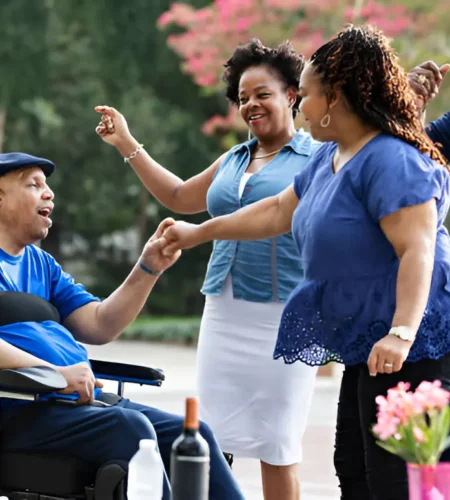What Is Supported Living?
Supported living is a person-centered approach that enables adults with disabilities to live in their homes or shared accommodations while receiving the help they need to manage daily life. Unlike institutional care, supported living promotes choice, dignity, and independence. Individuals can decide where they live, who they live with, and their routines, allowing them to shape their lives according to their preferences and goals. This model encourages self-reliance while providing a safety net of support.
By combining practical assistance with social engagement, supported living fosters independence and a sense of belonging within the community. Through supported living services, individuals receive tailored support in areas such as budgeting, meal preparation, healthcare coordination, and skill development while staying actively involved in their neighborhoods. This holistic approach empowers people to build meaningful relationships, pursue employment or hobbies, and live fulfilling lives as valued members of society.
How Services Are Customized for Each Person
The key to practical supported living lies in its adaptability. Support begins with a detailed assessment of an individual’s goals, preferences, and needs. From there, a person-centered plan outlines the type and frequency of support—ranging from coaching on cooking meals or household budgeting to assistance seeking employment or maintaining a schedule of medical appointments. Some individuals thrive with occasional check-ins, while others benefit from a daily presence or structured planning sessions.
Flexibility lets people control their daily lives and make choices that reflect their interests. Experts and advocacy organizations have affirmed this approach’s positive impacts on well-being and satisfaction. The movement toward custom-tailored support encourages independence and fosters personal growth, community engagement, and improved quality of life.
Developing and Maintaining Daily Life Skills
Mastery of daily living skills forms the core of a successful supported living experience. Skills like meal planning, personal hygiene, managing medications, and budgeting money can greatly enhance independence. Supported living services provide consistent guidance and positive reinforcement, helping individuals gradually build confidence in handling these tasks independently.
Ongoing support typically includes personalized coaching, group learning sessions, and adaptive tools to help overcome various barriers. For adults with disabilities, developing proficiency in these essential skills is not only empowering but also decreases long-term dependence on caregivers. Engaging in daily routines and decision-making enhances self-esteem and promotes long-term well-being.
The Importance of Community Connection
Social connection greatly impacts overall life quality, especially for adults with disabilities. Supported living emphasizes community integration, promoting participation in local events, educational activities, and volunteer groups. These relationships not only offer social benefits but also lay the groundwork for self-advocacy, independence, and resilience.
Many supported living programs help clients identify and pursue meaningful activities, from joining clubs to engaging in local governance or advocacy efforts. Through these experiences, adults with disabilities build relationships and discover new strengths, aspirations, and roles within their communities.
Improving Health and Well-being With Support
Access to coordinated health and wellness resources is a key benefit of supported living. Support workers help schedule medical appointments, manage medications safely, and connect individuals with counseling or mental health services as needed. This proactive approach addresses health issues early, promoting better wellness over time. Supported living can lead to clear improvements in both physical and mental health. With these supports, individuals are less likely to face preventable illnesses or care gaps, which is essential for maintaining long-term independence.
The Role of Technology in Supported Living
Technology has revolutionized how support is delivered within supported living environments. Smart home devices offer reminders for medication, appointments, or safety alerts, allowing for a greater sense of autonomy and security. Mobile communication tools connect clients and support staff effortlessly, ensuring that help is always available without being intrusive.
For some individuals, remote monitoring systems bring peace of mind while respecting privacy. Simple solutions—like text reminders, app-based schedule management, and video calls—can personalize support and allow individuals to participate more actively in daily life. These innovations enhance efficiency and dignity, bridging the gap between independence and necessary assistance.
Advocacy and Family Involvement
Successful supported living results from strong collaboration between individuals, their families, case managers, and advocacy groups. Families often play an essential behind-the-scenes role by participating in planning meetings, supporting accountability, and encouraging continued progress. Advocacy organizations add another layer of reassurance, championing the individual’s rights and helping navigate the complexities of care systems.
Transparent communication and regular feedback between everyone involved ensure that support strategies remain responsive to the individual’s changing needs. The collective investment from families and advocates helps clients build lasting confidence, make informed choices, and thrive independently within their chosen communities.
Looking Ahead: Trends in Supported Living
The landscape of supported living is continuously advancing. Greater focus is being placed on flexible service delivery, community-based housing models, and integration of cutting-edge technology. Public policies are evolving to emphasize the value of comprehensive, personalized care in the community rather than institutional settings.
As demand grows for inclusive housing options, supported living will likely become more accessible and commonplace—empowering more adults with disabilities to define and realize their version of a fulfilling, independent life. The future holds increased collaboration between public agencies, private providers, families, and advocacy groups, setting the stage for even stronger, more connected communities.


Comments